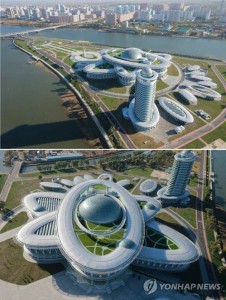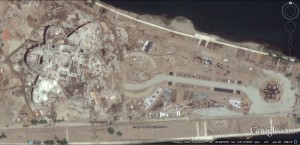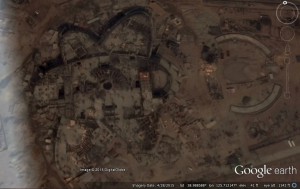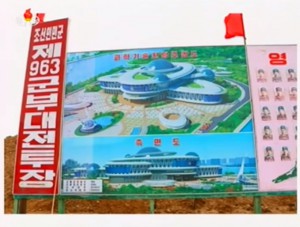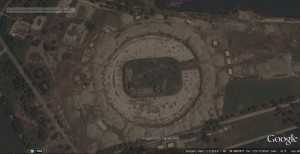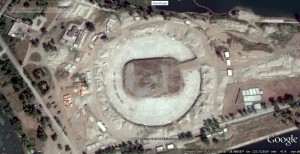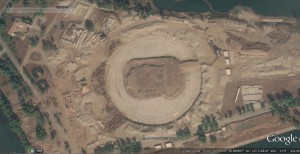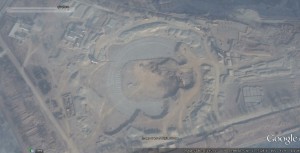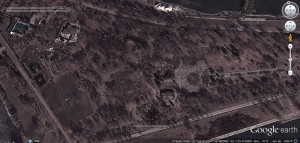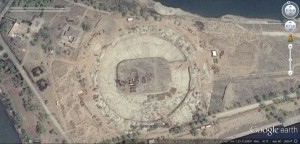UPDATE 9 (2015-10-28): KCNA reveals new photos of the completed Sci-Tech Complex:
Click image to see larger version.
UPDATE 8 (2015-8-12): KCNA reports a few more details on the functions/information of the complex:
Preparations for Running Sci-Tech Complex in DPRK
Pyongyang, August 12, 2015 17:23 KST (KCNA) — The Central Information Agency for Science and Technology in the DPRK has pushed ahead with the preparations for running the Sci-Tech Complex, which is now under construction in Pyongyang.The Agency concentrated its efforts on developing various kinds of service programs on a higher level. The programs include information retrieval system, database management system, print system and translation system.
It is also conducting at the final stage the work to synthesize and systematize a large amount of data.
Meanwhile, more than 1 000 multimedia pieces and scores of diagrams were produced.
UPDATE 7 (2015-7-10): New Google Earth imagery of the construction site reveals additional details of the project:
UPDATE 6 (2015-6-25): Google has uploaded a new image of the Sci-Tech Complex. The image is dated 2015-4-28. You can now see the distinctive “atom” shape the building will achieve:
UPDATE 5 (2015-4-4): The Pyongyang Times has published a new article on the Sci-Tech Complex:
Sci-tech complex construction goes full steam ahead
A sci-tech complex is being built on Ssuk Islet in the Taedong River meandering through the middle of Pyongyang.
The complex is almost equal to the Grand People’s Study House in both total area and height.
The Grand People’s Study House is a Korean-style building with an area of 100 000 square metres. It was completed in 1982 in a year and nine months after its groundbreaking.
It contributed greatly to making the whole society intellectual and developing the country’s science and technology.
The new centre is a palace of learning for all people as well as scientists and technicians. It is intended for making all people well-versed in science and technology. It will also serve as a centre for disseminating cutting-edge science and tech-nology across the country.
Latest architectural technologies are employed intensively to the construction.
A green building, the exterior is designed in the form of a large atomic structure symbolic of the world of science to make viewers feel at a glance that it is an information centre of science and technology.
Several flower-patterned outdoor exhibition grounds, study places, a fountain park and a science and technology tower will be built around the main building.
In the central hall that reaches up to the fourth floor will be installed a model of a carrier rocket of artificial earth satellite.
On every floor will be arranged e-reading rooms for professionals, where they can have access to any information in various fields, as befits a general e-library.
The layout includes sectoral sci-tech exhibition halls, online lecture room, room for the show of science film, local and foreign technological information exchange room for joint research and exchange and hall for presentations of scientific and technological achievements and workshops.
Also arranged in the complex will be children’s dream hall for helping them acquire scientific principles and cultivate a web of fantasy, basic knowledge application hall for schoolchildren and halls showing the history of the development of science and technology in the country.
It will be furnished with facilities to transmit information needed for sci-tech information rooms throughout the country.
A several-kilometre-long embankment will be built around the island to prevent flood water. Road extending more than four kilometres will be laid in the compound and the bridge linking the island to Chungsong Bridge will be rebuilt into a new three-way bridge branching into the island.
A trolley bus line is to be built, forming a loop line from Yokjon Street, via Mirae Scientists Street and Chungsong Bridge, to the island.
Tens of thousands of tall trees and flowering shrubs are planned to be planted on the island to landscape the surroundings of the complex and new species of turf over a large area will add to the beautiful scenery of the island.
It is a gigantic construction project with a huge workload.
Soldier builders engaged in the construction are now stepping up the project as scheduled to create a new Pyongyang spirit and Pyongyang speed in the “all-at-once” spirit of the Korean People’s Army of transforming mountains and rivers not in a decade but in a year.
After finishing the excavation for the foundations, the most difficult task, in the biting cold of midwinter they are pushing ahead with the concrete work for the foundations underground and the first floor.
The construction of a modern 500-capacity tower hotel, bridge leading to the island and the trolley bus line is being pushed in a three-dimensional way.
The builders in charge of the bridge are pushing forward with the project as planned by applying advanced construction methods to the building of cofferdam and excavation for the foundations of piers.
Civil servants cleared the site over several thousand square metres and planted over 3 000 trees and flowering shrubs in 15 species.
UPDATE 4 (2015-3-20): According to Radio Free Asia:
North Korea is building a science and technology facility on an unpopulated island in the capital Pyongyang to store digital information obtained in part by hacking foreign websites to help scientists and other professionals access outside know-how, sources from the country said.
“North Korea is building Science and Technology Hall, a massive information and communication service center for scientists, technicians and teachers who can’t access the internet,” someone who works for an educational institution told RFA’s Korean Service.
“If Science and Technology Hall is completed, they can see digital materials from all parts of the world such as international technical development trends and [information about] military, telecommunications and satellites,” the source said.
The facility, which is being built on Pyongyang’s Ssuk Island, will disseminate information to scientists and technicians via the country’s intranet, he said.
It will be connected to major universities in Pyongyang as well as research centers and laboratories in leading companies through a dedicated line, he said.
Construction has already started on the facility, which will collect and organize both domestic and global data, on Ssuk Island,” the Chosun Shinbo, the journal of the Chongryon (General Association of North Korean Residents in Japan), which represents the position of the North Korean regime, reported in January.
UPDATE 3 (2015-2-27): Kim Jong-un has made a second visit to Ssuk Islet to guide construction of the “Sci-Tech Complex”.
According to Rodong Sinmun:
The complex should serve as a seat of learning where not only scientists and technicians but also people from all walks of life can have an ample opportunity of learning and a center for disseminating latest science and technology throughout the country, he said, calling for constructing it to be impeccable in terms of architectural beauty and practical use.
He gave an instruction to build a hotel capable of accommodating 500 people which can match well its surrounding environment so that it may provide best convenience to visitors.
He called for pushing ahead with the construction of the complex and preparations for its operation simultaneously.He underscored the need to meticulously organize the work for building a strong latest science and technology database, supplying equipment and apparatuses necessary for e-library service at the highest level, establishing a network between the complex and scientific and technological knowledge dissemination rooms across the country and assigning scientists, experts and service workers.
He underlined the need to successfully undertake the embankment project on Ssuk Islet where the complex is located and effectively arrange environment around it including afforestation and greening.
He praised commanding officers and soldiers of KPA Unit 963 for contriving and introducing an innovative construction method and pushing ahead with the project in a bold way.
He said every sector and unit should render sincere material and moral assistance to the construction of the complex so that it may be pushed forward as a project involving the entire Party, the whole country and all people.
He was so kind as to solve all problems arising in the construction on the spot.
That last sentence I found particularly humorous.
UPDATE 2 (2015-2-1): The “scientific and technological study center” seems to have been re-designed over the last few months. Although construction on the old design had begun, the shape of the facility seems to have changed (was this a consequence of Kim Jong-un’s visit to the facility last year?):
(Image Dates: 2014-7-3, 2014-9-21, 2014-10-26, 2015-1-14)
UPDATE 1 (2015-1-9): According to the Institute for Far Eastern Studies (IFES):
The Choson Sinbo, pro-North Korean newspaper in Japan, reported on January 10, 2015 that a “Science and Technology Hall” is under construction on the Ssuk Islet on Pyongyang’s Taedong River. The hall is reported to serve as a “multi-functional technological service base which will conserve and maintain digitalized data of science and technological achievements made by mankind, and facilitate information sharing and exchanges through a network system.”
The newspaper stated, “The Republic with the national strategy to achieve economic revitalization through science and technology is emphasizing the need for informatization of educational materials in order to foster professionals in science and technological sector.” In also stressed, “In the Kim Jong Un Era, this project is under promotion to advance to the next level.”
Last June, Kim Jong Un visited the Ssuk Islet to provide field guidance for the “Ssuk Islet development project.” During the visit, Kim proclaimed, “The demand for scientific and technological knowledge sharing is increasing day by day,” and added, “Our Party [Workers’ Party of Korea] has decided to develop Science and Technology Hall in the Ssuk Islet to address the demands of the people.” According to the newspaper, the islet, which is situated at the gateway to Pyongyang, will be equipped with indoor and outdoor exhibition space and will “transform the scenery of the Taedong River.”
Last year, the faculty residence for the Kim Chaek University of Technology was completed (two, 46-story apartment buildings) on the riverside of the Taedong River. This high-rise, which looks afloat on the Taedong River, will be at the center of the currently-under-construction “Mirae [Future] Scientists Street.” This street will house various residential and public service buildings.
In particular, the newspaper claimed, “The economic trials suffered from the end of the 20th century with the blockade and sanctions from our adversaries has impeded the advancement of the information sector. Hence, the informatization of educational resources is one of the fastest measures to ensure the best conditions and environment for education.” It conveyed the Science and Technology Hall development in the Ssuk Islet will contribute to the efforts toward the “informatization of educational resources.”
It further elaborated, “The most pragmatic approach to meet the demand for knowledge dissemination is not to distribute compulsory literatures, teaching materials, and experimental equipment for every field and units which will require tremendous effort in terms of funds, materials and time.” Instead, the article stipulated that the more rational choice would be to “create a state-level system that can provide necessary information in digitalized data and share that information to the people.”
This can be interpreted as one of North Korea’s efforts to revitalize the economy through science and technology.
ORIGINAL POST (2014-6-3):
Imagery on Google Earth indicates the construction work on Ssuk Islet in Pyongyang began between 2014-1-27 (Top) and 2014-4-13 (Bottom)
On June 2, 2014, Rodong Sinmun/KCNA announced that Kim Jong-un visited Ssuk Islet in Pyongyang and “called for turning the islet associated with the feats of President Kim Il Sung into the one for scientific and technological study center.”
As shown in the satellite images above, construction on the new center had begun before Kim Jong-un made his visit.
KCNA goes on to describe aspects of the new center:
Saying that demand for the dissemination of science and technology is increasing as the day goes by, Kim Jong Un noted that the Party determined to build a modern scientific and technological study center on the islet to meet the requirements of the people.
The center to be built on the islet will function not only as a comprehensive data base for scientific and technological achievements made by mankind but also as a multi-purpose scientific and technological service center, which makes it possible to use all data and share and exchange information through a network any time, he noted.
He instructed officials to build the center at the highest level in the aspects of architectural beauty, formative art and architectural contents so that it may appear a building of national treasure and fashionable and world-class one.
Feasting his eyes on both banks of the River Taedong, he said the site was a very good place and the center to be built on the islet would serve as another springboard from which the country would surpass the world’s level. He added he felt pleased to foresee the center.
Noting that the scientific and technological study center to be built on the islet is another gift of the WPK for the people, he specified measures for designing, construction and the supply of building materials, etc.
